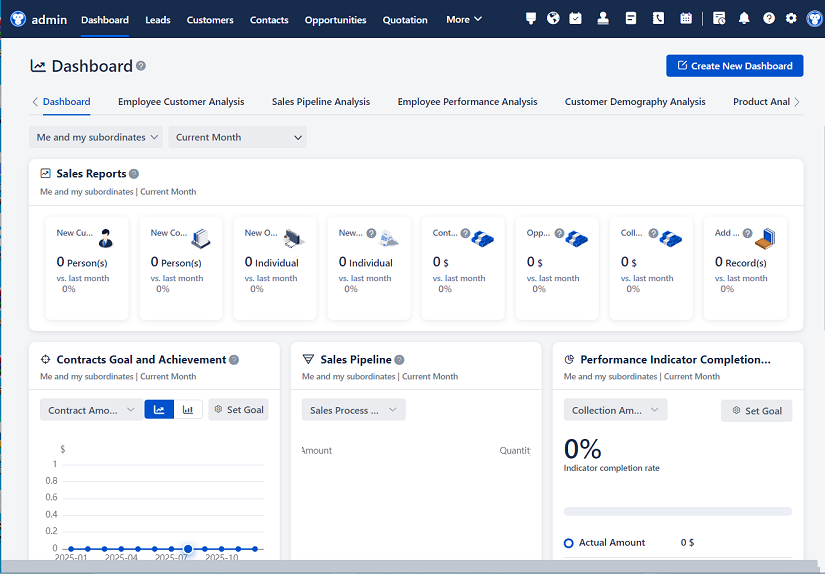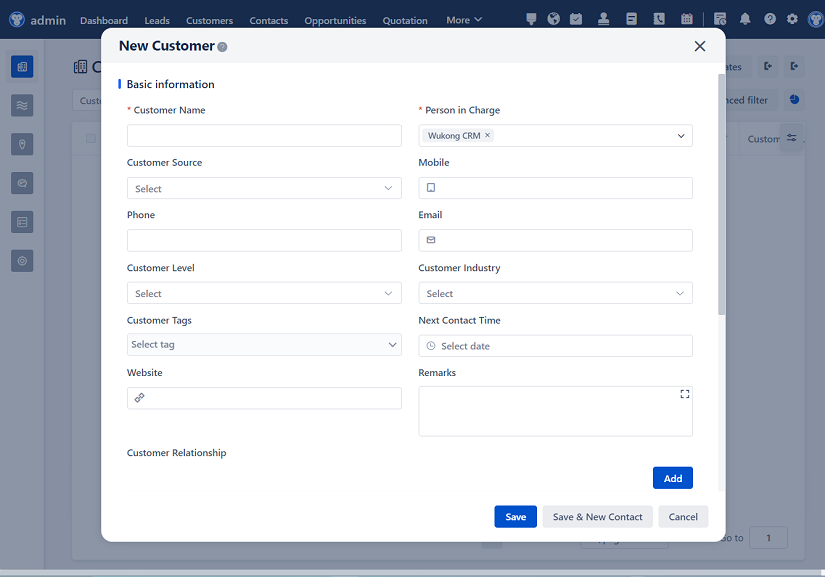
△Click on the top right corner to try Wukong CRM for free
Hey there! So, you've probably heard the term "Customer Information Management System" thrown around a lot, right? It's one of those buzzwords that everyone seems to be talking about. But what exactly is it, and why should you care? Well, let me break it down for you in a way that makes sense.

First off, imagine you're running a business, and you have all these customers. You know, the people who keep your lights on and your doors open. Now, wouldn't it be great if you could keep track of all their information in one place? That's where a Customer Information Management System, or CIMS for short, comes in. It's like having a super-organized digital filing cabinet, but way cooler and more useful.
So, what does this system actually do? Well, it helps you store, organize, and manage all the data you have on your customers. Think of it as a one-stop shop for everything from their contact details to their purchase history. And the best part? It's not just about storing data; it's about using that data to make your business better.
Now, I know what you might be thinking: "But wait, isn't that what a CRM (Customer Relationship Management) system does?" Good question! While they are similar, there are some key differences. A CRM is more focused on managing the entire customer journey, from lead generation to post-sale support. A CIMS, on the other hand, is more about the nitty-gritty details of the customer information itself. It's like the foundation on which a CRM can build.
One of the biggest benefits of using a CIMS is that it helps you get to know your customers better. When you have all their information at your fingertips, you can start to see patterns and trends. For example, you might notice that a certain group of customers tends to buy a specific product during a particular season. With that kind of insight, you can tailor your marketing efforts and even your product offerings to meet their needs. It's like being a mind reader, but with data!
Another cool thing about CIMS is that it can help you improve your customer service. Imagine a customer calls in with an issue, and you can pull up their entire history with your company in seconds. You know what they bought, when they bought it, and any previous interactions they've had with your support team. This means you can provide a more personalized and efficient service, which, let's face it, is what every customer wants.
But here's the thing: implementing a CIMS isn't just a matter of flipping a switch. It takes some planning and effort. First, you need to figure out what kind of data you want to collect and how you're going to use it. Then, you need to choose the right software. There are a ton of options out there, so it's important to do your research and find one that fits your needs and budget. Once you've got the software, you'll need to train your team on how to use it. And, of course, you'll need to make sure you're handling all that data securely and in compliance with privacy laws. It's a bit of a process, but trust me, it's worth it.

Speaking of security, that's a big deal when it comes to CIMS. You're dealing with a lot of sensitive information, and the last thing you want is for that data to fall into the wrong hands. So, you need to make sure your system has robust security measures in place. This includes things like encryption, access controls, and regular audits. It's also a good idea to have a clear data retention policy, so you're not hanging onto data longer than you need to. After all, the less data you have, the less there is to protect, right?
Now, let's talk about some of the challenges you might face when implementing a CIMS. One of the biggest is getting buy-in from your team. Change can be hard, and some people might be resistant to a new system. The key here is communication. Explain why you're doing this, how it will benefit the company, and, most importantly, how it will make their jobs easier. If you can show them the value, they're more likely to get on board.
Another challenge is data quality. Garbage in, garbage out, as they say. If the data you're putting into your CIMS is inaccurate or incomplete, the insights you get out of it won't be very useful. So, you need to make sure you have processes in place to ensure the data is clean and up-to-date. This might mean setting up regular data validation checks or even hiring a data analyst to keep an eye on things.
And then there's the issue of integration. Chances are, you already have a bunch of other systems in place, like your accounting software, your e-commerce platform, and maybe even a CRM. You don't want your CIMS to be a siloed system; you want it to play nicely with everything else. So, look for a CIMS that offers easy integration with your existing tools. This will save you a lot of headaches down the line.
Okay, so now you know what a CIMS is and why it's important. But how do you actually go about choosing the right one? Well, first, you need to define your requirements. What features do you need? Do you want something that's cloud-based or on-premises? How many users will you have? These are all important questions to consider. Next, do some research. Read reviews, talk to other businesses in your industry, and maybe even try out a few demos. Finally, make a decision based on what works best for your business. Remember, there's no one-size-fits-all solution, so what works for someone else might not work for you.
Once you've chosen your CIMS, the next step is implementation. This is where the rubber meets the road. You'll need to set up the system, migrate your existing data, and train your team. It's a good idea to have a project plan in place, with clear milestones and timelines. And don't forget to test, test, test! You want to make sure everything is working as it should before you go live.
After you've implemented your CIMS, the real fun begins. Now you can start to analyze the data and use it to make informed decisions. Maybe you'll discover a new market segment you hadn't considered before, or you'll find ways to streamline your operations. The possibilities are endless, and that's what makes a CIMS so exciting.
Of course, like any tool, a CIMS is only as good as the people using it. So, make sure you're regularly reviewing and updating your data, and that you're using the insights you gain to drive real change in your business. It's not just about collecting data; it's about using it to create value.

In the end, a Customer Information Management System is a powerful tool that can help you better understand and serve your customers. It's not just a fancy database; it's a way to build stronger, more meaningful relationships with the people who matter most to your business. And in today's competitive landscape, that can make all the difference.

Alright, I hope that gives you a good overview of what a CIMS is and why it's so important. But I'm sure you've got some questions, so let me answer a few of the ones I hear most often:
Q: Is a CIMS the same as a CRM? A: Not exactly. While both systems deal with customer data, a CIMS is more focused on the storage and management of that data, while a CRM is more about the entire customer journey, including sales, marketing, and support.
Q: How do I choose the right CIMS for my business? A: Start by defining your requirements, then do some research, read reviews, and try out demos. Make sure the system you choose integrates well with your existing tools and fits your budget.
Q: What are the main benefits of using a CIMS? A: The main benefits include better data organization, improved customer insights, enhanced customer service, and the ability to make data-driven decisions that can help grow your business.
Q: How do I ensure the security of the data in my CIMS? A: Implement strong security measures like encryption, access controls, and regular audits. Also, have a clear data retention policy to minimize the amount of data you're storing.
Q: What are some common challenges when implementing a CIMS? A: Common challenges include getting buy-in from your team, ensuring data quality, and integrating the CIMS with your existing systems. Clear communication and a well-thought-out implementation plan can help overcome these challenges.
I hope that helps! If you have any more questions, feel free to ask. Happy managing!

Related links:
Free trial of CRM
Understand CRM system
AI CRM Systems

△Click on the top right corner to try Wukong CRM for free